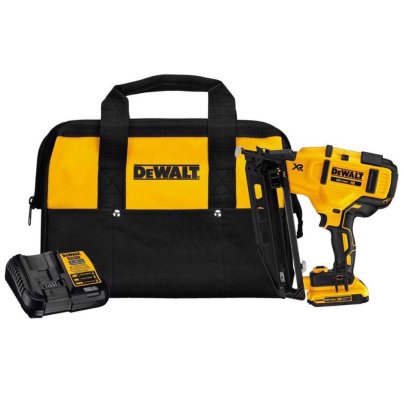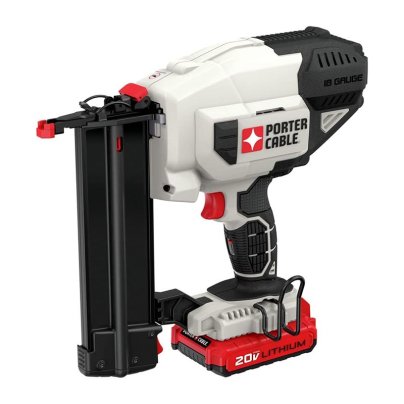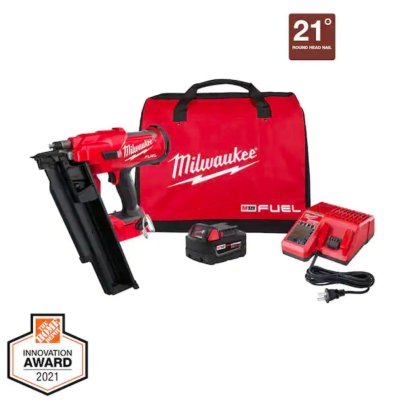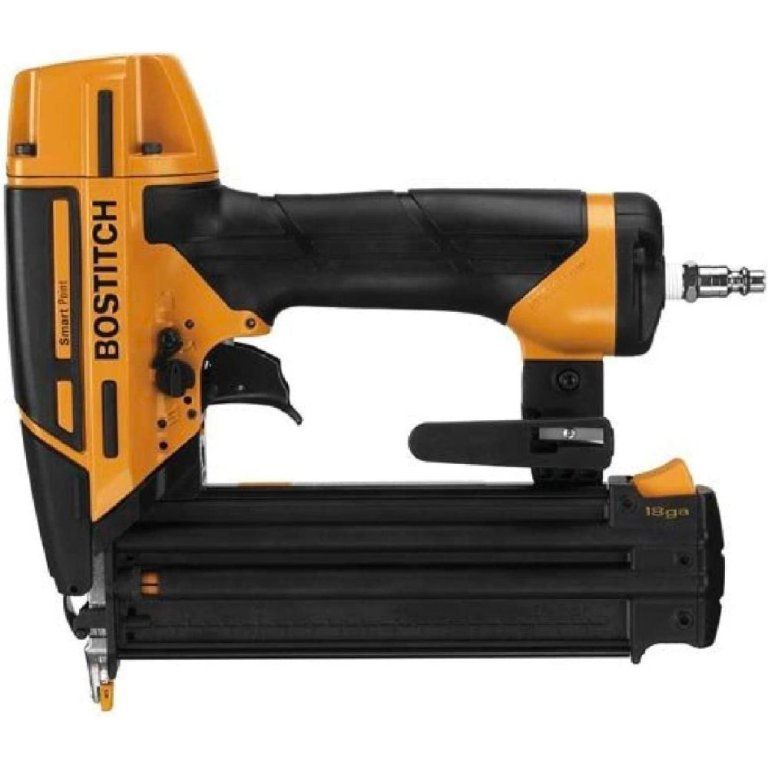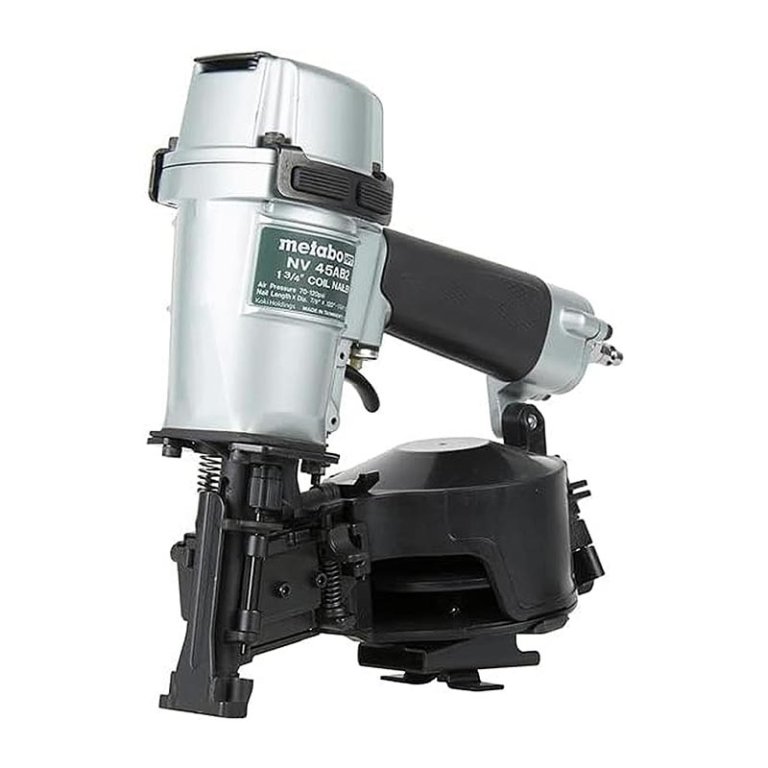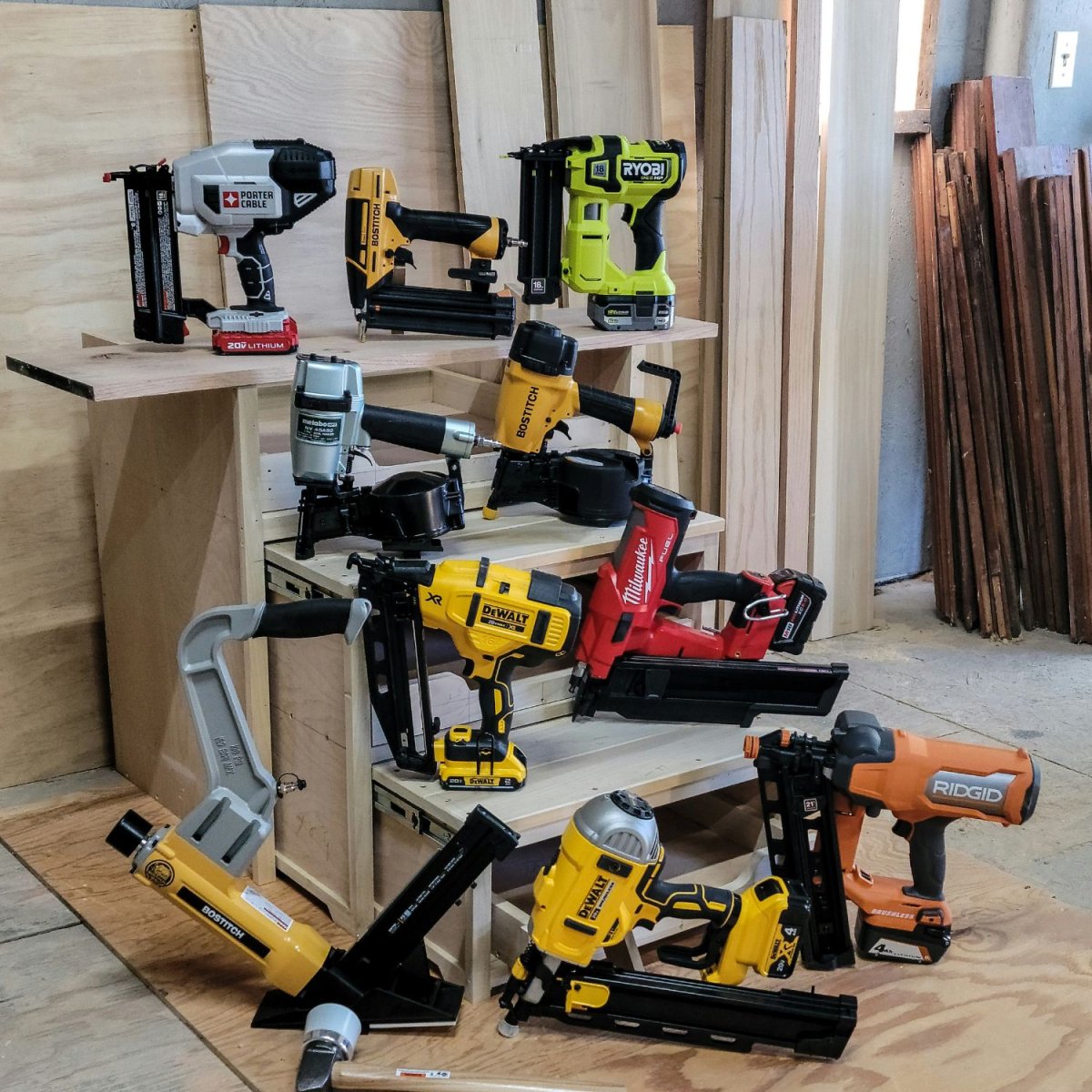
We may earn revenue from the products available on this page and participate in affiliate programs. Learn More ›
Whether you’re repairing a roof, redoing wood floors, or starting any other type of major do-it-yourself project, chances are you’ll want a nail gun (also called a nailer). This handy power tool drives nails or other small fasteners deep into the wood’s surface without splintering or harming the wood’s structural integrity.
We wanted to see which of today’s most popular nail guns would speed up our projects and drive nails accurately—so we decided to put them to the test. We tested a range of nail guns, including finish nailers, framing nailers, roofing nailers, siding nailers, and brad nailers. All of the picks on this lineup were top performers for various fastening tasks, but the DeWalt angled finish nail gun took top honors for power, precision, and an angled nail rail that makes it well suited for tight spots.
Today’s nailers are tailored to specific tasks, and getting the correct type for a project is essential. Below, we provide the info on finding the best nail gun for your next project, plus full details on how the following models earned a spot in our hands-on tests.
- BEST OVERALL: DeWalt 20V MAX 16 GA Angled Finish Nailer Kit
↓ Jump to Review - BEST BANG FOR THE BUCK: Porter-Cable 20V MAX 18 GA Cordless Brad Nailer Kit
↓ Jump to Review - BEST FRAMING NAILER: Milwaukee M18 FUEL 21-Degree Framing Nailer Kit
↓ Jump to Review - BEST BRAD NAILER: Bostitch Smart Point 18 GA Brad Nailer Kit and Nails
↓ Jump to Review - BEST SIDING NAILER: Bostitch 1¼-Inch to 2½-Inch Coil Siding Nailer
↓ Jump to Review - BEST FLOORING NAILER: Bostitch 2-in-1 Flooring Tool
↓ Jump to Review - BEST ROOFING NAILER: Metabo HPT 1¾-Inch Coil Roofing Nailer
↓ Jump to Review - BEST RAFTER FRAMER: DeWalt 20V MAX Cordless Framing Nailer Kit
↓ Jump to Review - BEST CORDLESS BRAD: Ryobi ONE+ 18V Cordless Brad Nailer
↓ Jump to Review
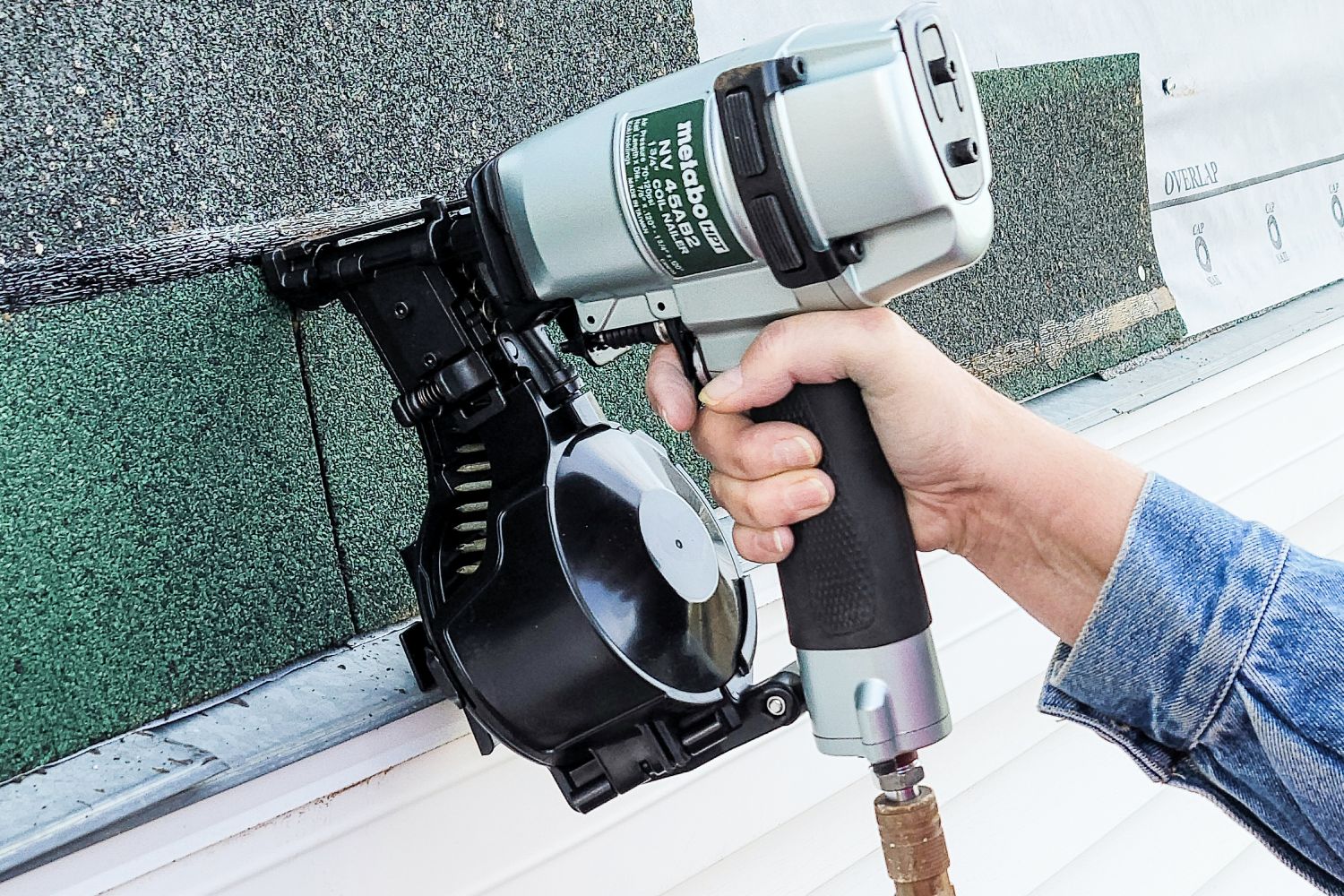
Nail Gun Comparison
| Product | Nail size | Power source | Model number |
| DeWalt 20V MAX 16 GA Angled Finish Nailer Kit | 16 gauge; 1¼ to 2½ inches long | Battery | DCN660D1 |
| Porter-Cable 20V MAX 18 GA Cordless Brad Nailer Kit | 18 gauge; ⅝ to 2 inches long | Battery | PCC790LA |
| Milwaukee M18 FUEL 21-Degree Framing Nailer Kit | 9 to 12 gauge, 2 to 3½ inches long | Battery | 2744-21 |
| Bostitch Smart Point 18 GA Brad Nailer Kit and Nails | 18 gauge; ⅝ to 2⅛ inches long | Pneumatic | BTFP12233 |
| Bostitch 1¼-Inch to 2½-Inch Coil Siding Nailer | 13 to 14 gauge; 1¼ to 2½ inches long | Pneumatic | N66C |
| Bostitch 2-in-1 Flooring Tool | 15½-gauge flooring staples or 16-gauge cleats; 1½ to 2 inches long | Pneumatic | BTFP12569 |
| Metabo HPT 1¾-Inch Coil Roofing Nailer | 11 gauge; ⅞ to 1¾ inches long | Pneumatic | NV45AB2 |
| DeWalt 20V MAX Cordless Framing Nailer Kit | 9 to 12 gauge; 2 to 3¼ inches long | Battery | DCN21PLM1 |
| Ryobi ONE+ 18V Cordless Brad Nailer | 18 gauge; ⅝ to 2⅛ inches long | Battery | P322 |
Our Top Picks
We tested a whole lot of nail guns, and the ones in this lineup represent the best models on the market today. The following nailers vary by type—some are designed for building structures, and others are made for installing trim or shingles, or attaching siding to a house. Each one excelled in our hands-on tests, and we feel confident in their performance and power.
Best Overall
DeWalt 20V MAX 16 GA Angled Finish Nailer Kit
Buy at Amazon Buy at Ace Hardware Buy at The Home DepotWhat We Like
- Adjustable depth ensures accuracy on different woods
- Angled nail rail for better maneuverability
- Single-fire or bump mode for versatility
- Quick-clear jam release
What We Don’t Like
- A pricey option
Specs
- Nail size: 16 gauge; 1¼ to 2½ inches long
- Power source: Battery
- Model number: DCN660D1
We didn’t set out to choose a finish nailer as our best pick, but the 16-gauge DeWalt angled finish nailer excelled in several areas. It’s not suitable for framing or installing shingles, but we felt it offered the best overall combination of features, power, and versatility.
DeWalt is a reputable manufacturer of both DIY and pro tools, so we were expecting this model to be a top performer, and it didn’t disappoint. After charging the battery fully, we loaded a strip of 20-degree 2½-inch 16-gauge nails in the rail. We shot nails into oak, walnut, and pine boards and, using the depth-adjustment feature, we changed the nailhead depth to suit the hardness/softness of the specific wood.
This finish nailer shot the nails flawlessly, even when we switched to bump mode and ran through the clip at a rapid pace. We then loaded a strip of 1¼-inch nails and continued testing. It shot the shorter nails just as smoothly as the longer ones. In all, we shot more than 250 nails, and the gun never jammed. That’s pretty impressive since some nail guns jam frequently when shooting in bump mode.
What our tester says: “I found the DeWalt angled finish nailer easy to use and comfortable to hold with its rubberized grip and ergonomic shape. If you’re looking for a powerful nail gun for baseboards, casing, stair risers, or for any other project where finish nails are called for, this might be your pick.”—Glenda Taylor, Product Reviews tester and writer
Get the DeWalt angled finish nail gun at Amazon, Ace Hardware, or The Home Depot.
Best Bang for the Buck
Porter-Cable 20V MAX 18 GA Cordless Brad Nailer Kit
Buy at Amazon Buy at Ace Hardware Buy at The Home DepotWhat We Like
- Affordable nail gun for the power and precision
- Good nail-depth adjustment adapts to various wood densities
- Quick-clear jam release makes removing stalled nails easy
What We Don’t Like
- Not an angled nailer, so not as handy in tight spots
Specs
- Nail size: 18 gauge; ⅝ to 2 inches long
- Power source: Battery
- Model number: PCC790LA
Trim carpenters don’t have to spend a lot to get a reliable brad nailer or pinner. The Porter- Cable 18-gauge brad nailer offers everything needed to install small or delicate trim and comes at an attractive price point.
We charged the Porter-Cable’s battery, loaded a strip of 2-inch 18-gauge nails, and started testing. We shot the nails into hardwood and softwood, and we used the tool’s nail-depth adjustment as we switched between woods of various hardness to ensure the heads of the nails ended up just below the surface of the wood.
The Porter-Cable shot nails smoothly and accurately. The gun jammed once when we were firing nails into knots in oak (something carpenters intentionally avoid to keep a nail gun from jamming), but the tool’s jam-release level made it simple to remove the jammed nail and continue testing.
The only downside to this brad nailer is the lack of an angled nail rail. It still works very well, but an angled rail would make it easier to use in tight spots. Still, for the price, this is a top performer for anyone who needs to install ceiling cove or other delicate trim. It does not have a bump mode, but many brad nailers do not, and that is not a detriment in a brad nailer where precision is more important than speed.
What our tester says: “I ran over 200 nails through this brad nailer, and I was impressed at its accuracy and power. It performed just as well when I tested it with shorter ⅝-inch nails.”—Glenda Taylor, Product Reviews tester and writer
Get the Porter-Cable nail gun at Amazon, Ace Hardware, The Home Depot, or Acme Tools.
Best Framing Nailer
Milwaukee M18 FUEL 21-Degree Framing Nailer Kit
Buy at The Home Depot Buy at Acme Tools Buy at Northern Tool + EquipmentWhat We Like
- Fires 3½-inch nails, longer than most competitors
- Angled nail rail for better maneuverability
- Rapid bump mode speeds many tasks
- Good nail-depth adjustment adapts to various wood densities
What We Don’t Like
- Doesn’t have a quick-clear jam release
- Pricey
Specs
- Nail size: 9 to 12 gauge, 2 to 3½ inches long
- Power source: Battery
- Model number: 2744-21
When it comes to shooting framing nails accurately, the Milwaukee M18 FUEL 21-Degree Framing Nailer Kit is a top achiever. After fully charging the battery, we loaded a strip of 2-inch framing nails and started testing by shooting the nails through ⅝-inch plywood stacked on 2×4 pine boards.
This framing nailer shot the nails powerfully into the wood—a little too powerfully (the heads were sinking), so we adjusted the depth gauge and were able to shoot the nails so the heads were flush with our plywood. We ran more than 100 two-inch nails through the gun and then tested 3-inch framing nails on stacked 2x4s. We switched the gun into bump mode and shot the nails at a rapid pace. This Milwaukee model is powerful. We didn’t experience any problem with nails not sinking as far as we wanted. The 21-degree angle of the nail rail also made the tool more compact and easy to use when nailing between 16-inch wall studs, a standard size spacing for both studs and joists.
It would have been nice to have a quick jam release, but a lot of framing nailers don’t include those, so when we had a jam in bump mode, we just removed the nail strip, used the on-tool wrench to open the front panel, and then pulled the jammed nail out with needle nose pliers.
Get the Milwaukee nail gun at The Home Depot, Acme Tools, or Northern Tool + Equipment.
Best Brad Nailer
Photo: AmazonWhat We Like
- Good nail-depth adjustment adapts to various wood densities
- Powerful nail deployment ensures nailheads don’t stick up
- Pointed tip assists in precise nail placement
What We Don’t Like
- Doesn’t come with angled nail rail
Specs
- Nail size: 18 gauge; ⅝ to 2⅛ inches long
- Power source: Pneumatic
- Model number: BTFP12233
We have long admired Bostitch nailers as well as their staplers, and this powerful little brad nailer was no exception. We connected it to our compressor via a hose; inserted a strip of 18-gauge 2-inch nails; and tested the gun on oak, walnut, and pine boards. It has an easy-dial depth adjustment we used when we switched between different hardnesses of wood, and we were able to shoot brads consistently with the heads just slightly countersunk, which is what we were hoping to do.
We shot more than 200 brads, switching back and forth between 2- and 1-inch lengths. The Bostitch didn’t jam in all that time, but if it had, we would have removed the jammed nail via its handy quick-clear jam release.
The Bostitch brad nailer doesn’t come with an angled nail rail, which would have been handy when we were shooting nails in tight spots, but it’s highly reliable, and it even comes with a bump (multifire) mode. Realistically, a bump mode isn’t often called for on a brad nailer since this type of nail gun is used chiefly for installing trim, which is a precise task that doesn’t lend itself to rapid firing.
Get the Bostitch Smart Point nail gun at Amazon, Ace Hardware, or Lowe’s.
Best Siding Nailer
Photo: AmazonWhat We Like
- Large coil capacity reduces reloads
- Powerful driving in both single and bump modes
- Good nail-depth adjustment adapts to various wood densities
What We Don’t Like
- No quick-clear jam release
- Unnecessary rafter hook
Specs
- Nail size: 13 to 14 gauge; 1¼ to 2½ inches long
- Power source: Pneumatic
- Model number: N66C
The Bostitch 1¼-Inch to 2½-Inch Coil Siding Nailer proved to be an efficient siding and fencing nail gun. Since a single coil of nails can come with 3,000 nails or more, this model will allow installers to move quickly without needing to stop frequently to refill the nails.
We connected the pneumatic siding nailer to our air compressor and inserted a coil of 2-inch by .092-inch galvanized nails. We shot nails into two types of siding: cedar and fiber-cement siding. The tool’s depth gauge allowed us to adjust the nail depth to suit the type of siding, so the nail heads sat flush with the material. We switched from single-fire mode to bump mode and could shoot the nails in quick succession in both types of siding.
The gun didn’t jam until we accidentally hit a nail that was already in the siding. It doesn’t feature a quick-clear jam release, but many coil nailers don’t, so we cleared the jam and continued testing.
The Bostitch siding nailer also comes with a swivel rafter hook that we thought should have been a belt hook since the tool is designed to be used on siding. An installer is going to need to pick up new siding strips frequently, and it would have been nice to be able to hang the tool on a tool belt rather than lay it down each time. Plus, rafters are usually not in the immediate vicinity when installing siding, so the rafter hook seemed like a poor design choice.
Get the Bostitch siding nail gun at Amazon, Menards, or Tools Plus.
Best Flooring Nailer
Photo: AmazonWhat We Like
- Fires cleats at precise angle; no guesswork
- Nails while locking flooring strips together
- Soft-grip handle reduces fatigue during long installs
- Accurate cleat insertion for professional-looking results
What We Don’t Like
- No quick-clear jam release
Specs
- Nail size: 15½-gauge flooring staples or 16-gauge cleats; 1½ to 2 inches long
- Power source: Pneumatic
- Model number: BTFP12569
The Bostitch 2-in-1 Flooring Tool works on a slightly different principle than the other nailers we tested, but not only did it save a lot of time, it also ensured that the hardwood strips were seated tightly against one another.
We tested it on an actual hardwood floor installation, and we liked it so much that we completed the whole floor with it. It sure beats the manual way of nailing each flooring strip by hand. We loaded the flooring nail gun with 2-inch-long 16-gauge nail cleats, which are nails with a tiny bend at the top rather than a traditional nailhead. It also accommodates 15½-gauge flooring staples.
After connecting the flooring nailer to the air compressor via a hose, we started nailing the strips. We positioned the Bostitch flooring nailer against the edge of the hardwood strip we wanted to attach. Rather than a trigger, this nailer features a mallet actuator, a knob that causes the nailer to fire a cleat when hit with the included mallet. It didn’t take a hard hit to get the nailer to fire—more of a firm tap.
Installing hardwood requires inserting a nail through the tongue side of a tongue-and-groove strip at an angle that goes through the tongue and into the subflooring. With the Bostitch, there was no guessing—the nailer shot each nail at just the right angle. In addition, when we hit the mallet actuator, the force of the nail firing helped secure the strip we were installing against the previous strip. Win-win!
Every cleat fired smoothly, and the nailer never jammed. If it had, however, we would have had to remove the jammed cleat manually since there is no quick-jam release option. We were delighted with the amount of time this nailer saved on installing hardwood flooring.
Get the Bostitch 2-in-1 nail gun on Amazon or Bostitch.
Best Roofing Nailer
Photo: AmazonWhat We Like
- Lightweight for easier rooftop carrying
- Shoots nails accurately for quick shingle installation
- Depth adjustment prevents proud or overdriven nails
- Rubber bumpers prevent tool from sliding off roof
What We Don’t Like
- No tool-belt hook
Specs
- Nail size: 11 gauge; ⅞ to 1¾ inches long
- Power source: Pneumatic
- Model number: NV45AB2
If there’s one place no one wants to have to refill nail strips frequently, it’s on a roof. That’s why coil roofing nailers are so popular with professional roofers, and the Metabo HPT 1¾-Inch Coil Roofing Nailer was just as good as any we’ve ever used. It shoots standard 11-gauge roofing nails from ⅞ to 1¾ inches long. We loaded in a coil of 1¾ -inch nails and connected the nailer via a hose to our portable air compressor and started testing.
We used this pneumatic nail gun to attach asphalt shingles to a shed roof. At first, the nailheads were slightly too high, so we adjusted the tool’s depth adjustment until they were flush with the shingles. We tested the Metabo in both single-fire mode and bump mode and found that it shoots quickly and powerfully. At one point, we must have hit a nail in the sheathing beneath the shingle, and the gun jammed. Clearing away the jam was simple though. We just opened the nose of the nail feeder and used a small rod and a hammer to tap it out.
A feature some may overlook that we appreciated was the rubber bumpers on the sides of the tool. This is great for those times the roofer has to lay the gun down on the roof when positioning a new strip of shingles—the rubber helps keep the tool from sliding off the roof. (This feature would be particularly helpful on this tool, as it doesn’t have a belt hook.) We also liked the rubber-coated grip that allowed us to get a firm grasp when using the tool. The Metabo is a sound roofing nailer, and we shot more than 150 nails during our test. Plus, it weighs just 5½ pounds, making it easy to take up on a roof.
Get the Metabo nail gun at Amazon, Lowe’s, or Menards.
Best Rafter Framer
Photo: The Home DepotWhat We Like
- Slightly compact design handy in tight spots
- Angled nail rail for increased maneuverability
- Adjustable rafter hook to stow quickly during jobs
- Quick-clear jam release
What We Don’t Like
- Not the most affordable
Specs
- Nail size: 9 to 12 gauge; 2 to 3¼ inches long
- Power source: Battery
- Model number: DCN21PLM1
Out of the three framing nail guns we tested, we selected the DeWalt 20V MAX Cordless Framing Nailer Kit as the best of the bunch for framing rafters. It’s also well suited to other framing situations, such as constructing stud walls, joist systems, or installing subflooring, but we felt that its slightly shorter nail rail (by 4 inches) put it at the top of our list for a more compact gun in tight spots. Plus, it has an adjustable rafter hook designed to hang on a rafter.
We loaded this wireless nail gun with a 21-degree strip of 3-inch framing nails and tested it on stacked 2×4 pine boards. It deployed the nails quickly and powerfully. We adjusted the nail depth and shot more than 100 nails using both the single-fire and bump modes. We didn’t get any jammed nails. We then switched to shorter, 2-inch nails and tested the gun’s efficiency for nailing ⅝-inch oriented strand boards (OSB) to pine boards. We had to adjust the nail depth slightly to accommodate the different materials, but we had no jams. This framing nailer comes with a release lever in case a nail does jam.
The nail gun’s 21-degree slanted rail also adds to the convenience of using it in tight spots. We wouldn’t hesitate to use this DeWalt in any framing situation, but we feel it’s a top choice for rafter-framing projects.
Get the DeWalt framing nail gun at The Home Depot, Grainger, or Acme Tools.
Best Cordless Brad
Ryobi ONE+ 18V Cordless Brad Nailer
Buy at The Home DepotWhat We Like
- Nail-depth adjustment enables trimming in different wood densities
- Single-fire and bump modes make tool very adaptable
- Powerful nail deployment for accurately seated nailheads
What We Don’t Like
- Unangled nail rail tough fit in tight spaces
Specs
- Nail size: 18 gauge; ⅝ to 2⅛ inches long
- Power source: Battery
- Model number:
The Ryobi ONE+ cordless brad nailer comes with a tip that helped us insert the nails exactly where we wanted them. While high precision isn’t always necessary with framing nailers, installing delicate trim work requires exact fastener placement, and this nail gun shines in that area. We liked the fact that it was cordless since many brad nailers are still pneumatic, and an air hose can get in the way at times.
We charged the battery, loaded a strip of 18-gauge 1-inch brad nails, and started our testing by shooting them into oak and walnut boards. At first, the nailheads were sitting a little too high, but we adjusted the nail depth until they were just below the surface of the wood. We shot more than 100 brads before switching to pine boards, where we had to lessen the nail depth to suit the softer wood.
We had three nail jams with the 1-inch nails, but the jams were easy to clear using the quick-clear jam release. We also tested the Ryobi by loading 1½ -inch brads, and we didn’t get any jams with those. In addition to the precision tip, this brad nailer also comes with a bright LED guide light that we found was helpful in low-lighting situations. It comes with a bump mode, which isn’t used often in precision trim installation. We would have preferred an angled nail rail instead, which would have made it easier to use the tool in tight spots.
Get the Ryobi nail gun at The Home Depot.
How We Tested the Best Nail Guns
| Testing Stats | |
| Products tested | 10 |
| Hours/Weeks/Time spent testing | Choose the time format that fits the category and add the time here, e.g. 2 weeks |
| Tests performed | [Please list the number of tests performed] |
| Price range | $95 to $530 |
Before testing the top nail guns on the market today, we extensively researched more than three dozen different types and models to determine how well users liked their performance. We considered national brands—it’s hard to beat the quality of DeWalt, Milwaukee, and Bostitch—but we didn’t rule out other brands, such as Metabo, a German brand that’s been a recent up-and-comer, and Ridgid and Ryobi, which are brands made and sold by The Home Depot.
For the actual testing, we loaded the guns with nails of the appropriate sizes and used them to insert fasteners that corresponded with their purposes. For brad and finish nailers, we shot nails into hardwoods and pine. When testing framing nailers, we shot nails into pine boards and through sheet materials like plywood and OSB. We tested roofing nailers on shingles and the flooring nailer on real hardwood flooring strips. We fired more than 1,500 nails during our comprehensive hands-on testing.
We awarded points based on a rubric for each test we performed. The better the tool did, the higher the score it received. After the testing, we averaged each tool’s score and used those numbers to create the corresponding awards.
What to Consider When Choosing the Best Nail Gun
In addition to the size of nails that a nail gun accommodates, consider the type of nail gun, whether a battery or an air compressor powers the nail gun, how many nails the gun will hold, and whether it’s designed to shoot one nail at a time or allows the user to shoot nails rapidly. Accuracy is also important—no one wants to spend valuable time pulling nails that didn’t shoot correctly.
Types of Nail Guns
The expression “the right tool for the job” has never been truer than with nail guns. Select one based on the task(s) and type of nailing project from this list of the most common types of nail guns.
- Framing nail guns are the go-to for putting up a wood structure quickly and securely. A framing nailer offers the power and precision to hold everything in place for decades to come.
- Finish nail guns are designed for installing trim, like baseboards, doorways, and chair rails. They can handle tougher projects, too, like securing a standard floorboard to the drywall behind it.
- Brad nail guns, which fire nails that are slightly smaller in diameter, called brads, are best for delicate trim and custom woodworking projects in which a larger nail might ruin the wood.
- Flooring nail guns, also called “cleat nailers,” secure floor planks to the subfloor below. They speed up the flooring installation process and ensure that each nail is inserted at the correct angle.
- Roofing nail guns are made to drive nails into roofing materials such as tar paper, asphalt, and shingles. They often come with cylindrical cases that hold coils of nails.
- Palm nail guns are lightweight nailers that fit in the palm of the hand to deliver nails in tight corners and tricky angles on woodworking projects. While not practical for framing or large-scale projects, they come in handy in close quarters.
- Pin nail guns are the same thing as brad nailers. They shoot small brads and are best suited to detailed trim work. Much of the time, they’re simply called “pinners.”
Power Source
Nail guns are powered by either batteries or by air compressors. Nail guns without a compressor are powered by battery, so they’re cordless, pricier, and can deliver anywhere from 400 to 1,600 shots per charge. Because they’re not tethered to a cord, battery-powered nail guns can be used anywhere, but they can weigh a hefty 7 pounds or more.
Pneumatic nail guns are powered by air compressors, so they can continue shooting for as long as they’re plugged in and loaded with nails or brads. They weigh 2 to 5 pounds on average and are generally less expensive than, or comparable to, battery-powered nailers. Thanks to their light weight, easy handling, and long runtime, pneumatic nailers remain a popular choice.
Coil vs. Strip Nailer
Nail guns are classified as being either coil nailers or strip nailers (also known as stick nailers), terms that refer to how nails are housed inside the tool. Because coil nailers hold nails in a tight coil, they offer a larger capacity—up to 3,000 nails or more in a single coil. Stick or strip nailers hold nails in a straight line, so they hold fewer nails, typically less than 100, depending on the size of the nails.
Firing Mechanism
Nail guns all come with a single-deploy firing mechanism, but some also offer a rapid-deploy mode. In single mode, the user presses the tip of the nail gun firmly to the material and then squeezes the trigger to fire a nail. It’s a two-movement method: press, then squeeze.
In rapid-deploy mode (also called bump mode), the user holds the trigger down and then pushes the gun’s tip to the material, which triggers a shot. This is the fastest way to shoot nails because the user doesn’t have to pull the trigger each time. Almost all framing, roofing, and siding nailers have bump modes, and some finish guns (but not all) have them as well.
Nail Capacity
Nail capacity indicates the range of nail sizes the nailer will shoot. Nail guns are made to hold specific nail gauges, meaning nail thickness. For example, the nail gun might shoot 16-gauge nails (a standard finish nail size), but it will also shoot different lengths of 16-gauge nails. The range of nail lengths will be listed in inches, such as 1¼-inch to 2-inch.
When it comes to nail guns for framing, the nails they accept can vary in thickness and length. Instead of using a gauge measurement, the gun will specify the actual nail thickness range, such as 0.113 inches to 0.148 inches. The nail length range will also appear, such as 2 inches to 3¼ inches.
Nail-Depth Adjustment
Early nail guns didn’t come with the ability to adjust the depth of the nail, but most of today’s models offer that feature, and it’s pretty handy. When installing trim, carpenters countersink the nails so the heads are just below the surface of the wood. This allows them to go back and fill the nail holes with putty to create a smooth, flat surface.
Nail-depth adjustments are just as necessary on framing nail guns where the nail heads should sit flush with the material when installing sheet materials such as plywood sheathing or subflooring. Roofing nailers, which are primarily pneumatic, don’t usually offer nail-depth adjustment, but the roofer can adjust the air pressure on the compressor to adjust the nail depth.
Angled Nail Rail
Some nail guns are listed as being “angled.” This just means the rail that holds the nail strips slants upward—toward the tool’s base. Most angled rails slope around 20 or 21 degrees, although some slope up to 34 degrees. They also require nail strips that correspond to the angle. For example, a 21-degree nail gun will only accommodate 21-degree nail strips.
This does not affect the angle at which the user shoots the nail, however. That’s controlled by the gun’s position when shooting. That said, an angled rail is handier in some nailing situations because the angle makes the tool more compact and easier to maneuver in tight spots.
FAQs
Those buying their first nail gun may have a few additional questions about nail guns in general.
A 16-gauge finish nail gun or an 18-gauge brad nailer is best for installing baseboards.
Use single-fire mode when a high level of precision is necessary. Use multifire (bump) mode when speed is of the essence.
Like all power tools, nail guns present a risk of injury if used unsafely. Read and follow all safety instructions before using a nail gun.
You can, but manufacturers have been making fewer and fewer, and you’ll find more options with pneumatic and cordless nail guns.
Yes, though nothing too intensive. Nailers should be cleaned and lubricated, and for pneumatic guns, the compressor should be drained. Wiping gunk off the gun to prevent corrosion can help prolong its life, and you should pay close attention to the components and troubleshoot if you notice any kind of damage.
This depends entirely on the type of projects you’ll be tackling. If you plan on using your nail gun for more heavy-duty tasks, like framing or subflooring, a lower-gauge gun would be more appropriate, whereas higher-gauge guns may be better suited for lighter-duty work, like trim and molding projects.
Yes, if the alternative is paying someone else to do whatever project you’ve got in mind, buying a nail gun and doing it yourself can certainly be worth it. For frequent tinkerers, the answer is probably yes, it’s worth it. But if you don’t see yourself frequently working on projects that require a nail gun, you might not need to invest in one.
Meet the Tester
Glenda Taylor is a contractor, product tester, and writer focusing primarily on construction and power tools. She tests a wide range of power tools as well as other home improvement, household, and lawn-and-garden products.
Additional research provided by Amy Lynch.
